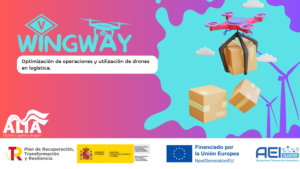wingway; drone integration in supply chain Client Spanish Ministry of...
Read MoreModus; Multimodal transportation analysis
Client
Industries
Solutions
ABOUT SESAR 2020
SESAR is a European Union (EU) sponsored program for researching the future of air traffic management in Europe. The SESAR 2020 phase, funded by Horizon 2020 program, the EU’s research and innovation €80 billion funding programme, builds on its predecessor, SESAR 1, to deliver high-performing operational and technological solutions for uptake by the aviation industry.
SESAR 2020 supports projects to deliver solutions in airport operations, network operations, air traffic services, and technology enablers. Through its Exploratory Research projects, SESAR 2020 looks beyond the current R&D to investigate new ideas, concepts, and technologies, but also to challenge preconceived notions about air traffic management and the aviation value chain.
The challenge of multimodality in aviation
Seamless passenger journeys call for the optimization and alignment of air transport systems with other modalities such as rail, road, or public transportation. Improved multimodality across the European transport network will help passengers make the best choices in the future. Learn more about our work in passenger transportation and mobility.
The Modus project, led by European research institute Bauhaus Luftfahrt, sought to model a seamless door-to-door multimodality and passenger experience to evaluate the impact of an improved joint air-rail transport system for a variety of different passenger types and in various future potential scenarios. The project sought to assess the impact of passenger choice on capacity, predictability, and the environment, across different scenarios and for multimodal journeys.
In order to complete end-to-end multimodal journey models, a gap was found in the generation of probability distributions defining the travel cost (length and travel time) of inter-modal exchanges and door-to-kerb / kerb-to-door phases. These stages of travel are less known and impacted by complexities of urban mobility in different transportation modes (private vehicle or public transportation). This is needed to calculate joint probability distributions with dependencies to other phases. It was thus decided to generate synthetic datasets representing hypothetical routes in intermodal connections and last-mile mobility using geospatial data available for urban areas and surroundings (peri-urban).
A travel cost model for urban itineraries in multimodal journeys
As a result, Skymantics was asked to develop a urban/peri-urban transportation model to generate costs of inter-modal itineraries for exchanges between air and rail transportation in several European city archetypes. For this, Skymantics used its advanced routing engine to build geospatial models simulating the cost of routes between airports and other locations in an urban environment. Learn more about our Advanced Routing Engine.
Locations included railway stations and city centres, but also any point in the city and surrounding region that is relevant as an origin or destination of travel. The resulting datasets represented catchment areas per route cost function, defined concentrically around airports. These results were then used to generalize the travel time and create one function that represents each of the airport-city archetypes sampled. A travel time probability distribution was generated dependent on the population density within the catchment area of a city-airport archetype.
The results of Skymantics work were critical to achieve an accurate end-to-end long-haul model for air and rail passenger transport that includes urban and peri-urban itineraries in mode exchanges and last mile. This task made use entirely of Open Data – OpenStreetMap (OSM), GTFS data provided from local and regional Governments, and GEOSTAT. Open Data is transparent, publicly verifiable, and has no access barriers for collaborative communities.
Interested in learning more about our advanced routing capabilities or requesting a demo?
Contact us
Other success stories
Collaborative AI forest harvest planning tool for British Columbia
COLLABORATIVE AI FOREST HARVEST PLANNING TOOL FOR BRITISH COLUMBIA Client...
Read MoreDigital transformation in airports
Digital transformation in airports Client U.S. Department of Energy, Office...
Read More


